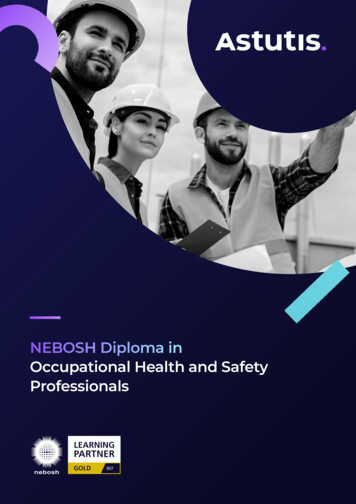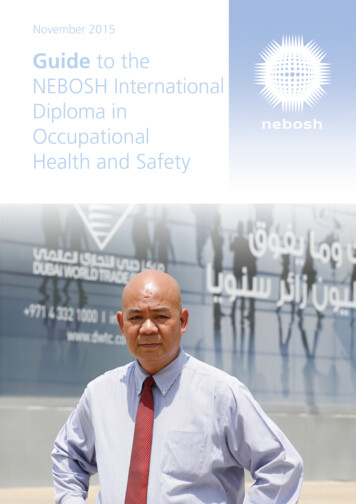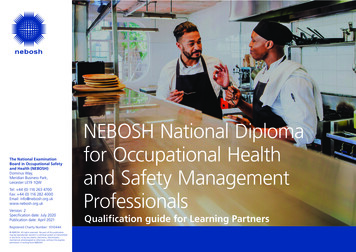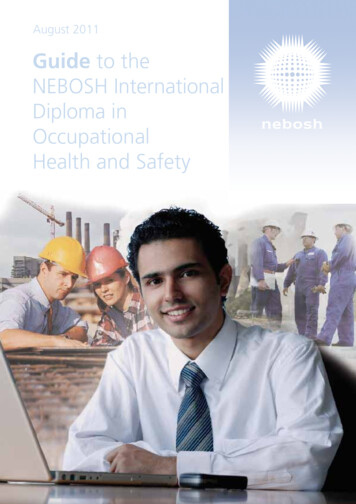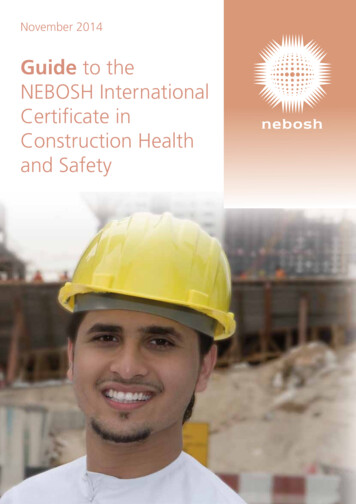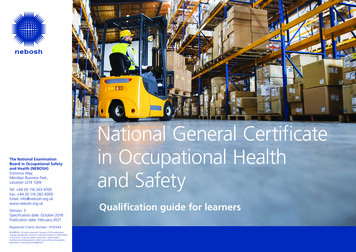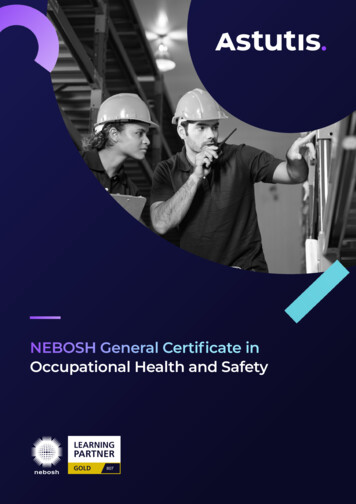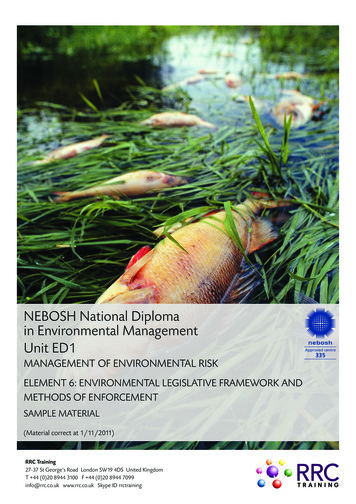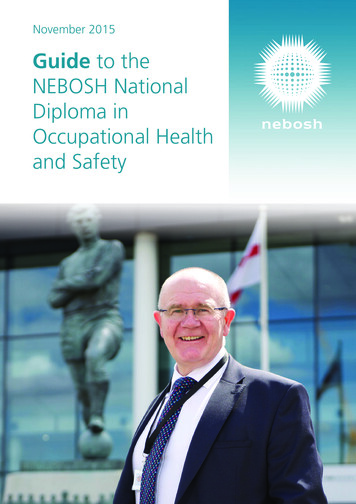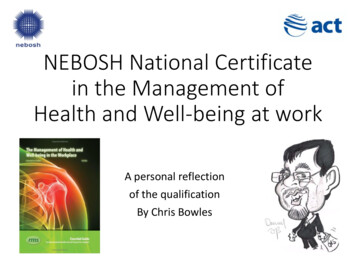
Transcription
NEBOSH National Certificatein the Management ofHealth and Well-being at workA personal reflectionof the qualificationBy Chris Bowles
Background to qualificationWhile many H&S professionals are familiar with NEBOSH GeneralCertificates and even Construction and Fire Certs, this was a newcertificate lunched in 2010, to redress the balance in H&S.This qualification is designed to provide the skills and knowledgeto tackle health and wellbeing at work; achieving productivitygains, reducing absence and providing a better place to work.The syllabus emphasises practical management solutions toworkplace health with reference made to clinical issues to enablemanagers to understand how these contribute to the preventionof ill-health and promote rehabilitation.It was aimed at Managers, Supervisors, HR & Safety professionals.
Background to me doing itI had successfully completed NGC and Fire Cert.I was just recovering from a period of ill-health (Workrelated stress and depression) which was partlywork-related, during which I was often concerned bylack of awareness by employers to such issues andwhat was the best practice available, that could helpothers suffering such problems.So as part of my recovery I decided to study H&WbCert to learn more and to encourage my employer tobe more aware and manage such issues better.
The Benefits for employersHealthy workers can be almost three times more productivethan their unhealthy colleagues. People who are unwell eitherdon’t perform at their best, or they don’t turn up for work atall. On average, every worker in Britain takes over 7 days offannually because of illness. In the public sector the average isalmost 10 days per year per employee.A correctly implemented health and well-being programmewill help reduce absenteeism and staff turnover, leading toincreased skill retention, and a reduction in training andrecruitment costs. Employee physical and mental well-beingwill be protected and improved, increasing staff morale andleading to increased productivity. The cost savings to theorganisation canbe significant.
Elements: Topics covered1. Intro to workplace health2. Effects of health on work3. Effects of work on health4. Management of attendance5. Management of mental health at work6. Management of MSDs7. Workplace health promotion8. Workplace health supportMin 36 hrs tuition and 18 hrs private study.
AssessmentStandard 2 hour exam: Section 1: one 20 mark longer question Section 2: ten 8 mark shorter questions.(Pass mark 45%)Health and Well-being practical application:H&Wb review of a workplace; complete a proforma,review findings and write a management report.(Pass mark 60%)Pass: 105-124, Credit: 125-144, Distinction: 145
Typical section 1 question1. A company is planning to introduce a permanent nightshift to cope with an increasing demand for theirproducts. A committee of professionals, including safetyrepresentatives and human resources personnel, are in aconsultation phase relating to the implementation of thenight shifts.a) Identify FOUR possible health effects to employeesfrom shift work other than fatigue. (4)b) Outline the consequences of fatigue on anemployee’s work performance. (4)c) Outline the precautions the employer should take toreduce the health effects to the employees who willbe working permanent night shifts. (12)
Typical section 2 questions6. Mental health disorders are experienced by a significant proportion of theworking population.a)Identify FOUR types of mental health disorders. (4)b)Outline FOUR sources of external support available to employees andemployers in relation to mental health. (4)8. Outline the role of health assessments for a new employee. (8)9. Identify the possible range of specialists involved in occupational healthprovision within a large manufacturing company AND outline their specificrole within occupational health. (8)11. A road worker is operating a hand-operated tool to split concrete,subjecting their hand and arms to high levels of vibration. Identify controlmeasures that could be considered to reduce the risk of developing hand-armvibration. (8)
Practical Proforma
Management report
What did I get from it?Although I felt I was already quite aware, both fromprevious H&S studies and generally, it improved myawareness of the key issues causing ill-health and howthey could be better managed, for the benefit of bothemployees and employers.It built on previous H&S training but It focused theattention back to “Health” rather than “Safety” as the bigissue, more deaths and lost time!I became aware of “presentism” as an issue and howmental health conditions can sometimes be a benefit!Personally, it helped me to rationalise how my ownhealth and Well-being had been managed or not.I would whole-heartedly recommend this course to bothHealth and Safety professionals and H&W Champions.We all need to be more “pro-active” on H&Wb.
Hard work but worth it! my thanks also to my tutor at ACT
The following slides give more information on:NEBOSH and their qualifications including H&W Cert.ACT Associates; who provided me with excellent training.They run open courses and can provide in company courses.Please contact:Emma.Griffiths@actassociates.co.ukNEBOSH are continually reviewing their qualifications andwould like to get feedback on this offering and how to makeit more relevant and meet current needs in our professionand industry. Please contact:Matthew.Powell-Howard@nebosh.org.uk
Who we are NEBOSH (The National ExaminationBoard in Occupational Safety and Health)was formed in 1979 as an awarding bodywith charitable status We offer 18 qualifications in environmentaland health and safety management (EHS) In our sector, NEBOSH qualifications inEHS management are the mostrespected and prominent in themarketplace
Our QualificationsMasters MRes (2013) / MSc (2015)Diploma in Regulatory Occupational Health and Safety(Level 7/11)Diploma(Level 6/10)Certificate(Level 3/6)Award(Level 2/5)Accepted by professional bodies for membership – IOSH,IIRSM, IEMA
National Certificate in theManagement of Health and Wellbeing at WorkKey topics Identifying risks to health at work Learning how to manage sickness absence andimplement a return to work programme Prevention and management of work related stress Workplace health promotion Disability discrimination and protecting health at work Dealing with mental health at work Working effectively with health professionals.
National Certificate in theManagement of Health and Wellbeing at WorkWho is it designed for? General ManagersSupervisorsHR ManagersSafety Professionals (rather thanOccupational Health Practitioners)
Unit NHC1: Managing Health andWell-being in the WorkplaceElement No.12345678Element TitleIntroduction to workplace healthEffects of health on workEffects of work on healthManagement of attendanceManagement of mental health at workManagement of people withmusculoskeletal disordersWorkplace health promotionWorkplace health support
Unit NHC1: Managing Health andWell-being in the WorkplaceAssessed by: One two-hour written examination consistingof ten ‘short-answer’ questions (8 markseach) and one ‘long-answer’ question (20marks) One practical examination, based onidentification of workplace health and wellbeing issues in the candidate’s ownworkplace.
Audit Consultancy TrainingAudit Legal compliance Management systems: ISO 45001/OHSAS 18001,ISO 9001, ISO 14001Consultancy Management systems, Independent review, Gapanalysis, incident investigation, Competent personTraining Classroom, E-learning, Blended learning, In-house20
NEBOSH Health and Well-beingCertificate CoursePublic Courses Available throughout the year at our WalsallvenueIn-house option also available21
NEBOSH Health and Well-beingStudy Guide Meets the current NEBOSHsyllabus Presented in full colour withillustrations and photographs Sample practical assessmentForward from Dame Carol BlackThanks to ACT for giving us five copies of this book,for the book draw at our Conference.22
NEBOSH are continually reviewing their qualifications and . Diploma in Regulatory Occupational Health and Safety (Level 7/11) Diploma (Level 6/10) Certificate (Level 3/6) Award (Level 2/5) Accepted by professional bodies for membership -IOSH, IIRSM, IEMA. National Certificate in the


